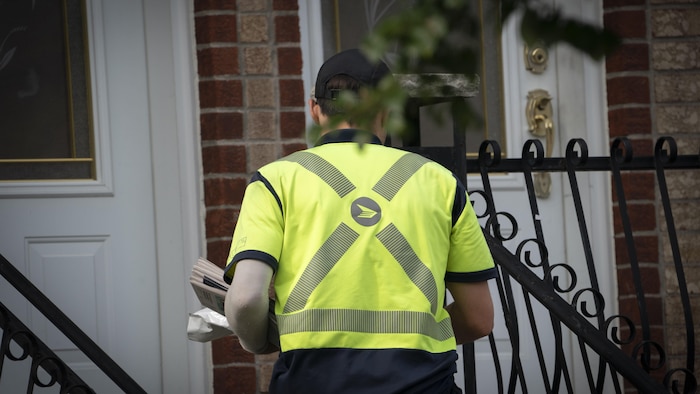Nearly 55,000 Canada Post workers have been on strike since 1 a.m. Friday following the failure of ongoing negotiations to renew their employment contract.
The Union of Postal Workers (CUPW) gave the employer and the federal Minister of Labor 72 hours’ notice on Tuesday, announcing the triggering of a work stoppage as of 1 a.m. Thursday night in Friday.
Canada Post responded shortly after by issuing a lockout notice. The strike mandate was adopted by 95% by postal workers in October.
Canada Post, however, clarified that it did not really intend to lock out its workers.
Strike or lockout?
Some confusion surrounded the conflict this morning to the extent that the union claimed that the employer had indeed resolved to impose a lockout following discussions which ended late in the night.
Canada Post, for its part, claims that there is no lockout and that the work stoppage stems entirely from the union’s decision to walk out. Canada Post was determined to continue its activities, we assure you.
Open in full screen mode
The 55,000 postal employees affiliated with CUPW stopped working at 1 a.m. on the night of Thursday to Friday.
Photo: Radio-Canada / Jean-Philippe Robillard
In interview on the show’s microphone All one morningon ICI PREMIÈRE, Yannick Scott, national director of the Metropolitan Montreal region for CUPW, explained that the negotiations ended with an ultimatum from the employer.
The Company announced to the union that no matter what they did or did not do today, they would put their lockout into effect and take away the rights of our collective agreement to exchange them for the rules of the Canadian Code of work.
However, Canada Post management did not officially impose a lockout, but did so de facto, according to the former Quebec director of the Canadian Union of Public Employees (CUPE), Marc Ranger.
The employer did not send a new notice to cancel its first notice [de lock-out]. His first opinion had all the qualities of what we call a lockout, he explained on ICI RDI.
As soon as working conditions are modified to put economic pressure on employees, the Canadian Code [du travail] attribute it to a lockout. The employer, Canada Post, is playing with words for a public relations operation to avoid seeming like the bad guy, believes Mr. Ranger, who is now a strategic advisor at Ryan Public Affairs.
Mail processing interrupted
Canada Post is disappointed with CUPW’s decision to close postal service by launching a national strike. This decision will have significant and immediate impacts on millions of Canadians, small businesses and charities who rely on Canada Post during the busy holiday season, Canada Post said.
A quote from Canada Post
As for mail and packages that are already in Canada Post facilities, they will be secured and delivered as soon as possible upon resumption of activities according to the principle of first in, first out, continues Canada Post, which anticipates disruptions well after the end of the strike.
In addition to better salaries, postal workers are demanding better work-family balance as well as improved health and safety conditions.
Canada Post is introducing new mail delivery systems that mean that mail carriers are now out 8 hours delivering and some are walking 30 km.
In Western Canada, we have mail carriers who walk 30 km every day, which is the equivalent of two and a half marathons per week.
A quote from Yannick Scott, national director of the Metropolitan Montreal region for CUPW
In large urban centers, the change in schedules means that workers now arrive home very late and often spend their entire shift outside, regardless of the weather conditions, deplores the union.
The parties have been trying to reach an agreement for almost a year.
A new model is required, according to management
Canada Post, for its part, claims that its offer to union members is competitive (11.5% salary increase over four years), taking into account the revenue losses it has had to deal with since 2018.
Despite this, Canada Post has continued to present offers that protect and improve what is important to our current employees […] while protecting their defined benefit pension plan and provisions relating to job security, we assure.
In fact, Canada Post plans to offer, among other things, a parcel delivery service seven days a week and more competitive prices to its customers. This new delivery model is essential for the future of the company, explains the state-owned company, which claims to have lost $3 billion since 2018.

Open in full screen mode
A Canada Post letter carrier
Photo : Radio-Canada / Ivanoh Demers
No return to forced labor, according to Ottawa
Asked this morning in Montreal about the start of this strike, federal Labor Minister Steven MacKinnon said he is monitoring the situation from minute to minute.
There are many difficult and thorny issues at the negotiating table and very little progress recorded, he said, adding that all the resources of his department are mobilized to help the parties reach an agreement.
Asked about the government’s desire to force postal workers back to work, as was recently done in the port and rail industry sectors, Steven MacKinnon declared that he was not there yet.
We are not considering this at this time. We invest all our efforts at the table, between the parties, in order to facilitate a negotiated agreement.
The package is king
Over the years, Canada Post has evolved from a company that mainly delivered mail to a package handling and delivery company. It was in 2006 that mail volumes reached their peak in the country, with 5.5 billion letters processed. In 2023, Canada Post delivered less than 2.2 billion letters.
Despite the increase in deliveries in 2023, revenues from parcel delivery by Canada Post fell 2.5% to $3.4 billion.
Canada Post estimates that parcel volumes from Canadian e-commerce are expected to double over the next decade, indicates the organization’s most recent annual report.

